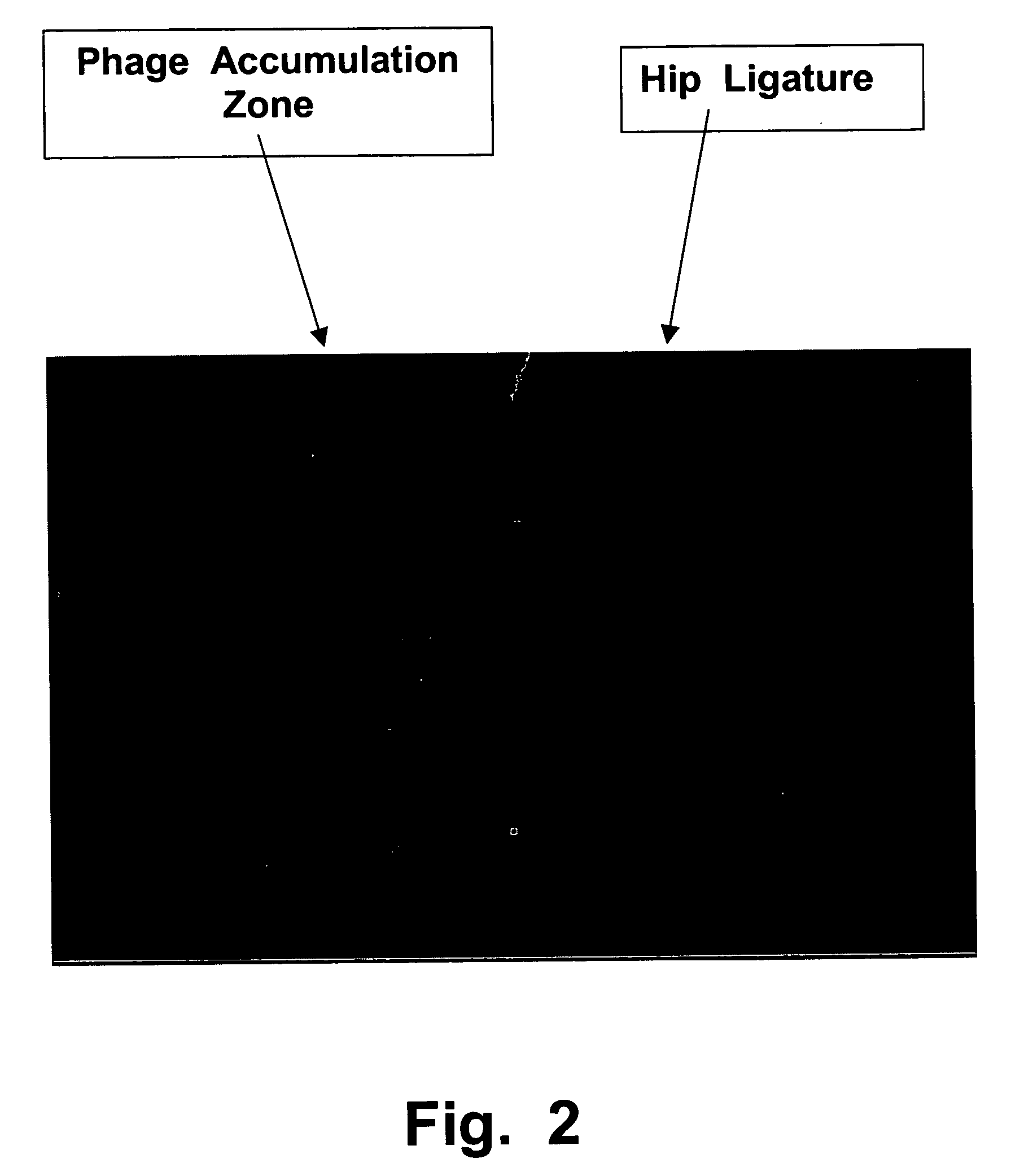Identification of ligands that enable endocytosis, using in vivo manipulation of neuronal fibers
- Summary
- Abstract
- Description
- Claims
- Application Information
AI Technical Summary
Benefits of technology
Problems solved by technology
Method used
Image
Examples
example 1
Phage Types and Libraries
[0213] M13KO7 helper phages can be purchased from various commercial suppliers, such as New England Biolabs (www.neb.com) and Amersham Biosciences (www4.amershambiosciences.com). This strain of helper phage contains fully functional genes that encode both the pIII and pVIII coat proteins. It also contains an origin of replication (from plasmid p15a) which is tightly controlled in a manner that results in low copy numbers in bacterial cells. It also contains a mutated (Met-40-Ile) copy of the phage M13 pII gene, which is essential for phage replication; this mutation causes it to be secreted by E. coli cells, as phage particles, in low copy numbers. It also carries a kanamycin resistance gene, inserted at the Ava I site within the M13 origin of replication. This kanamycin gene functions as a selectable marker in E. coli host cells that are not resistant to kanamycin. Additional information on using and culturing these helper phages is available from commerci...
example 2
Cell Types, Traits, and Methods
[0219] Except as otherwise noted, all phage amplification and titering used the TG1 strain of E. coli, from Cambridge Antibody Technology. This strain, which was specifically designed and developed for working with M13 phages, is also sold by companies such as Stratagene (La Jolla, Calif.; www.stratagene.com). Additional information describing culturing and transformation methods for this strain can be downloaded at no cost from the websites of commercial suppliers.
[0220] Among other features, the TG1 strain has a “lacIq” repressor gene which, together with catabolite repression by glucose, negatively regulates a “lac” promoter that has been placed in control of expression of the M13 gene that encodes the pIII phage coat protein. Most types of M13 phages that are used with TG1 cells contain an “amber” stop codon, inserted at the start of the pIII gene. As described below, this allows expression of pIII polypeptides (including chimeric pill polypeptid...
example 3
Cross-Linking of P75 Receptor-Binding Antibodies MC192) to M13KO7 Helper Phages
[0228] A monoclonal antibody preparation known as MC192 (and by similar terms, such as clone 192; originally described in Chandler et al 1984) is commercially available from various suppliers, such as Cell Sciences (www.cellsciences.com) and Chemicon (www.chemicon.com). These monoclonal antibodies bind to “low affinity” (p75) nerve growth factor receptors on rat neurons. Monoclonal antibodies that bind to human p75 receptors are also available, from companies such as United States Biological (www.usbio.net).
[0229] Unlike various other monoclonal antibodies that also bind to p75 receptors in rats, the MC192 antibody can trigger endocytosis of the antibody-receptor complex, leading to neuronal uptake of the MC192 antibody. This has been shown by studies using radiolabelled antibodies (Johnson et al 1987, Yan et al 1988).
[0230] To evaluate the ability of the MC192 antibody to drive endocytosis of phages i...
PUM
| Property | Measurement | Unit |
|---|---|---|
| Transport properties | aaaaa | aaaaa |
| Molecular structure | aaaaa | aaaaa |
| Affinity | aaaaa | aaaaa |
Abstract
Description
Claims
Application Information
 Login to View More
Login to View More - R&D
- Intellectual Property
- Life Sciences
- Materials
- Tech Scout
- Unparalleled Data Quality
- Higher Quality Content
- 60% Fewer Hallucinations
Browse by: Latest US Patents, China's latest patents, Technical Efficacy Thesaurus, Application Domain, Technology Topic, Popular Technical Reports.
© 2025 PatSnap. All rights reserved.Legal|Privacy policy|Modern Slavery Act Transparency Statement|Sitemap|About US| Contact US: help@patsnap.com



